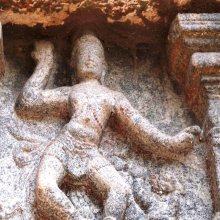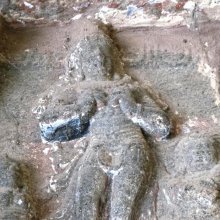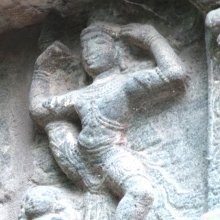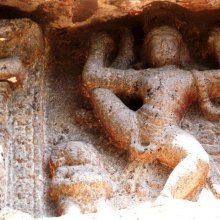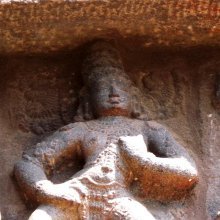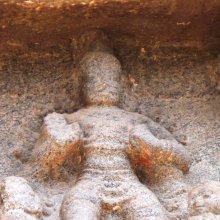Alapallava: 6 definitions
Introduction:
Alapallava means something in Hinduism, Sanskrit. If you want to know the exact meaning, history, etymology or English translation of this term then check out the descriptions on this page. Add your comment or reference to a book if you want to contribute to this summary article.
Images (photo gallery)
(+4 more images available)
In Hinduism
Natyashastra (theatrics and dramaturgy)
Source: Wisdom Library: Nāṭya-śāstra1a) Alapallava (अलपल्लव) refers to a gesture (āṅgika) made with a ‘single hand’ (asaṃyuta), according to the Nāṭyaśāstra chapter 8. It is also known by the name Alapadma and Alapadmaka. The hands (hasta) form a part of the human body which represents one of the six major limbs (aṅga) used in dramatic performance. With these limbs are made the various gestures (āṅgika), which form a part of the histrionic representation (abhinaya).
1b) A gesture (āṅgika) made with ‘dance hands’ (nṛttahasta), according to the Nāṭyaśāstra chapter 8. The hands (hasta) form a part of the human body which represents one of the six major limbs (aṅga) used in dramatic performance. With these limbs are made the various gestures (āṅgika), which form a part of the histrionic representation (abhinaya).
Source: archive.org: Natya Shastra1) Alapallava (अलपल्लव).—A type of gesture (āṅgika) made with a single hand (asaṃyuta-hasta);—(Instructions): All fingers turned towards the palm, standing on its side and separated from one another.
(Uses): It is to be used for indicating prevention, words like “Of whom are you,” “It is not,” “nonsense” and a woman’s allusion to herself.
2) Alapallava (अलपल्लव).—A type of gesture (āṅgika) made with dance-hands (nṛttahasta);—(Instructions): The two hands to have the Udveṣṭita Karaṇa in their movements. The Dance-hands are to be used in forming Karaṇas.
Source: Shodhganga: Elements of Art and Architecture in the Trtiyakhanda of the Visnudharmottarapurana (natya)Alapallava (अलपल्लव) refers to one of the thirty Nṛttahastas or “dance hand gestures” (in Indian Dramas), according to the Viṣṇudharmottarapurāṇa, an ancient Sanskrit text which (being encyclopedic in nature) deals with a variety of cultural topics such as arts, architecture, music, grammar and astronomy.—The hasta-mudrās (lit. “hand-gestures”) are very essential to denote some particular action or state in dancing and these mudrās are formed with the help of hands and fingers. In the Viṣṇudharmottarapurāṇa, thirty kinds of nṛttahastas (“dance-hand gestures”) are mentioned. e.g., alapallava. The practice of these nṛttahastas is strictly prohibited in sickness of body, in old age, in fear, drunk and anxiety.

Natyashastra (नाट्यशास्त्र, nāṭyaśāstra) refers to both the ancient Indian tradition (shastra) of performing arts, (natya—theatrics, drama, dance, music), as well as the name of a Sanskrit work dealing with these subjects. It also teaches the rules for composing Dramatic plays (nataka), construction and performance of Theater, and Poetic works (kavya).
Shilpashastra (iconography)
Source: Shodhganga: Vaisnava Agamas And Visnu ImagesAlapallava (अलपल्लव) or Alapallavamudrā refers to one of the various hand-poses (hastas or mudrās) defined in treatises such as the Pāñcarātra, Pādmasaṃhitā and Vaikhānasa-āgamas, extensively dealing with the technical features of temple art, iconography and architecture in Vaishnavism.—Pallavamudrā resemble Ādānahasta in which the palm and finger are slightly bent and the palm faces upward. If the finger are let loose, it appears to be Alapallava-mudrā. In the icon of Olayakunnam and of Palani, this [Pallavamudrā] hand is used to hold the lotus.

Shilpashastra (शिल्पशास्त्र, śilpaśāstra) represents the ancient Indian science (shastra) of creative arts (shilpa) such as sculpture, iconography and painting. Closely related to Vastushastra (architecture), they often share the same literature.
Languages of India and abroad
Sanskrit dictionary
[Sanskrit to German]
Sanskrit, also spelled संस्कृतम् (saṃskṛtam), is an ancient language of India commonly seen as the grandmother of the Indo-European language family (even English!). Closely allied with Prakrit and Pali, Sanskrit is more exhaustive in both grammar and terms and has the most extensive collection of literature in the world, greatly surpassing its sister-languages Greek and Latin.
Kannada-English dictionary
Source: Alar: Kannada-English corpusAlapallava (ಅಲಪಲ್ಲವ):—[noun] (dance) a single hand-gesture in which the fingers are separated and turned round in the palm beginning from the little finger, to indicate prevention, expressions like questioning as to 'who' 'what', 'why' etc.
Kannada is a Dravidian language (as opposed to the Indo-European language family) mainly spoken in the southwestern region of India.
See also (Relevant definitions)
Starts with: Alapallavahasta, Alapallavamudra.
Ends with: Phalapallava, Rasalapallava.
Full-text: Alapadmaka, Alapadma, Nrittahasta, Aralakhatakamukha, Urahparshvardhamandali, Alapallavamudra, Asamyuta, Ardhanikuttaka, Alapallavahasta, Yama, Sucividdha, Catura.
Relevant text
Search found 3 books and stories containing Alapallava; (plurals include: Alapallavas). You can also click to the full overview containing English textual excerpts. Below are direct links for the most relevant articles:
Vishnudharmottara Purana (Art and Architecture) (by Bhagyashree Sarma)
2.2. Hand Postures (c): Nṛtta-hasta < [Chapter 3 - Drama and Dance]
Natyashastra (English) (by Bharata-muni)
Chapter IX - Gestures of Major Limbs (aṅga)
Chapter IV - Description of the Class Dance (tāṇḍava)
Dance Traditions of South India < [January-February 1935]
Dance Traditions of South India < [May-June 1935]
